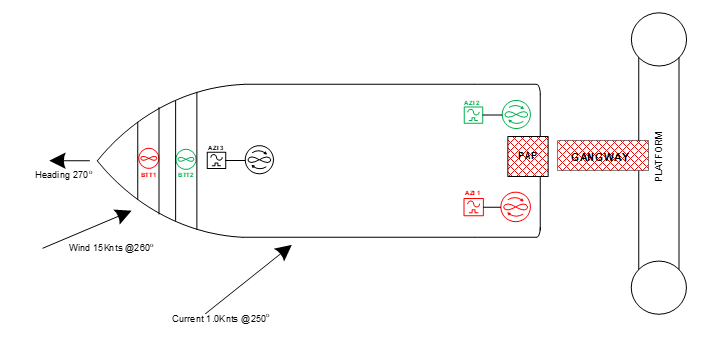Case Study – Consequences of Not Following ASOG
1 Overview of event
An SOV was approaching a Platform for personnel transfer via use of onboard Personel Access Platform (PAP) and the Platform’s gangway. When the distance was approximately 1 metre between the gangway and the PAP, there was a sudden rejection of the vessel’s starboard azimuth thruster by the vessel’s DP system without any warning. The ‘ready’ signal was lost to DP Control for the starboard Azimuth thruster. The vessel started to drift astern.
After a few seconds, the starboard azimuth thruster readiness indicator on the Vessel’s DP Console showed ‘ready’. The DPO on duty immediately re-selected the thruster back into operation. After the re-selection of the previously failed thruster, the vessel continued to drift astern with the stern starting to rotate slowly to starboard. As the PAP was very near to the gangway, it made contact with the gangway and incurred damage. During the drift, the gangway also snagged against the ship’s structure at the ship’s stern.
The DPO immediately tried to move the vessel away using the DP joystick but found response was slow. The Master, who was at the manual thruster console at that time, immediately instructed the OOW to switch the vessel to manual control. He then took over command using manual control and manouevered the vessel away to avoid further collision with the platform. During the manoeuvre, the gangway which was snagged with vessel’s stern structure was dragged. It subsequently came detatched from it’s securing point on the Platform and finally remained suspended off the platform by its rigging.
There was no injury to personnel reported.

2 What Happened
While the vessel was manoeuvring into position to prepare for passenger transfer, the DP system reported an intermittent failure of one of two aft azimuth thrusters causing the starboard thruster to be incapacitated and de-select from DP Control, however the DP system still showed the thruster as ready, the operator re-selected the thruster back into DP Control.
The vessels DP system calculation was distorted by the inclusion of an unresponsive thruster and therefore could not stablise.
The vessel could not hold position with the remaining Bow and Port azimuth thrusters.
3 What can be concluded?
- The vessel operating outside its post WCF environmental conditions prior to the loss of the thruster
- The vessel was in a drift on position therefore situational awareness and possibly activity planning was inadequate given the environmental conditions being such that the vessel could not hold position with loss of one thruster.
- The ASOG was not followed as it stated that if the vessel status changes, then the re-selection of failed equipment is to be carried out only when it is in a safe position. The DPO shouldn’t have reselected the thruster back into DP whilst alongside the platform. DP operations should have been safely stopped and vessel moved to safe location before the DP system was recovered.
- The DP event report did not conclude why the DP Joystick response was slow.
4 Guidance that would be relevant
The following IMCA Guidance would be relevant to this case study:
DP Event
Published: 11 August 2022
Download: IMCA DPE 02/22
Submit a Report
The following case studies and observations have been compiled from information received by IMCA. All vessel, client, and operational data has been removed from the narrative to ensure anonymity.
Case studies are not intended as guidance on the safe conduct of operations, but rather to assist vessel managers, DP operators and DP technical crew in appropriately determining how to safely conduct their own operations. Any queries should be directed to IMCA at [email protected]. Members and non-members alike are welcome to contact IMCA if they have experienced DP events which can be shared anonymously with the DP industry.
IMCA’s store terms and conditions (https://www.imca-int.com/legal-notices/terms/) apply to all downloads from IMCA’s website, including this document.
IMCA makes every effort to ensure the accuracy and reliability of the data contained in the documents it publishes, but IMCA shall not be liable for any guidance and/or recommendation and/or statement herein contained. The information contained in this document does not fulfil or replace any individual’s or Member's legal, regulatory or other duties or obligations in respect of their operations. Individuals and Members remain solely responsible for the safe, lawful and proper conduct of their operations.
